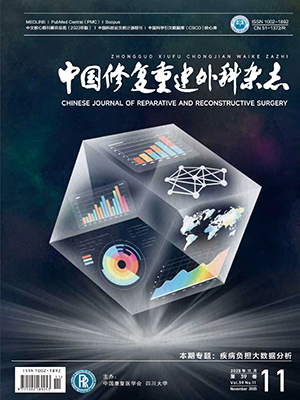Objective To evaluate the effect of tissue engineered skin with isogeneic cells on repairing skin defects in inbred rat model so as to provide relevant evidences for the clinical application. Methods The skins of newborn inbred F344 rats were harvested and treated with Dispase trypsin to isolate the epidermal cells. The skins of adult Sprague Dawley rats were obtained and treated with hypertonic sodium-SDS-trypsin to prepare the acellular dermal matrix. The tissue engineered skin was reconstructed by submerging culturing and air-liquid interface culturing in vitro. The full-thickness skin defects of 1.5 cm × 1.5 cm in size were prepared along the dorsal both sides of 36 adult inbred F344 rats, and 72 defects were repaired with tissue engineered skin in experimental group (n=24), with allogeneic acellular dermal matrix in negative control group (n=24), and with autologous full-thickness skin in positive control group (n=24). Finally the gross observation, the survival rate, wound contraction rate, and histological observation were used to evaluate the effect. Results The wound healed by first intension at 4 weeks postoperatively in the experimental group; the grafts connected with the adjacent tissue tightly and had normal appearance. At 4 weeks after operation, the survival rate of the graft was 0 in the negative control group; the survival rates were 62.5% (15/24) in the experimental group and 91.7% (22/24) in the positive control group, showing significant difference between 2 groups (χ2=5.779, P=0.016). The wound contraction rates of the experimental group and positive control group were significantly lower than that of the negative control group (P lt; 0.05), but no significant difference was found between the experimental group and positive control group (P gt; 0.05). Histological observation showed that slight inflammation reaction appeared at 1 week postoperatively in the experimental group; the regeneration of the blood vessel and the proliferation of the fibroblasts in dermis and the gradual maturation of epidermis were observed at 2 weeks, and new collagen deposition and collagen remodeling in the dermis of the graft were found at 4 weeks postoperatively. Conclusion The tissue engineered skin is able to repair full-thickness skin defect of rats effectively, it has similar effect to the autologous full-thickness skin in preventing the wound contraction and promoting the wound healing, which provides experimental evidences for the clinical application.
Citation: DONG Li,MA Shaoying,XU Yongjie,ZHANG Yumin,WANG Xusheng,LI Baoxing. EXPERIMENTAL STUDY ON REPAIR OF SKIN DEFECTS BY TISSUE ENGINEERED SKIN WITH ISOGENEIC CELLS. Chinese Journal of Reparative and Reconstructive Surgery, 2012, 26(11): 1375-1380. doi: Copy
Copyright ? the editorial department of Chinese Journal of Reparative and Reconstructive Surgery of West China Medical Publisher. All rights reserved




